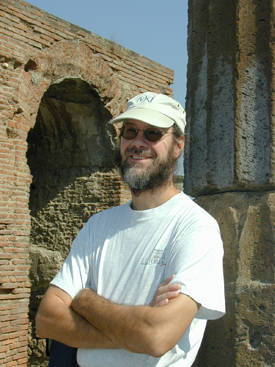Meet the IBEX Team: Geoffrey Crew

As the Interstellar Boundary Explorer spacecraft continues to collect particles from the edge of our Solar System, back on Earth, the mission team continues to work to receive the signals from the spacecraft and analyze the data. April's Monthly Highlight features Geoff Crew, IBEX Science Operations Center (ISOC) software development lead from the Massachusetts Institute of Technology (MIT).
Geoff grew up in Connecticut and New Jersey, the middle of three boys. Geoff's father, a chemist researching drug metabolism, served as the boys' Scoutmaster. His mother is a French and Spanish teacher. Geoff says of his eventual trend toward science, "I figured out during high school that science was easier for me than my peers, so I drifted in that direction. I also noticed that my father had cool stuff in his lab."
Geoff says that he doesn't really recall any grand ambitions when he was younger, though science, technology, and space did resonate with him. "I certainly was influenced by the space program of the 60's. I remember building Rangers, models of some of the first lunar probes, out of Tinker Toys, and Surveyors, the second generation lunar missions, out of toothpicks and glue (my technology improved with NASA's) and tossing them out the window."
"I was fortunate to go off to Dartmouth College for a fine education, majoring in mathematics and physics. I tended more towards physics out of a sense of it being of more practical use. In college, I had gotten some excellent exposure to plasma physics and that took me to MIT, working in support of the fusion energy program. Some may recall the oil shock of the 1970's. It was pretty clear, even then, that we needed to move away from imported oil and the projected atmospheric carbon dioxide problem and find some other way to satisfy our energy needs, and fusion was (and still is) a good prospect. Unfortunately, coming onto the job market with a newly minted Ph.D. at a time when the new administration had concluded we didn't need fusion due to an abundance of coal resources turned out to be bad timing, to say the least.
"Fortunately for me, virtually the entire universe is made of plasmas! I didn't have to look too far - almost the next building over at MIT, in fact - in order to find something useful to do. I wound up working on a variety of space plasma physics topics in the Earth's ionosphere and magnetosphere. That lasted for the next half-dozen or so years until circumstances reached a dry spell. Having put down some roots, and discovering some folks at MIT with a keen need for someone with my peculiar set of skills, I shifted up and further away from Earth into astrophysics. I also discovered it made for much easier chit-chat at cocktail parties.
"So the next 15 years were spent working on galactic X-ray sources and extra-galactic gamma-ray bursts. In parallel, I worked on a Small Explorer mission named HETE, the High Energy Transient Explorer, built by an extremely small team. I actually did a bit of almost everything on the mission." Geoff is not kidding when he says this. He was the crane operator whenever the team needed to lift the spacecraft. The team's machinist was the fork-lift operator. This tiny team built and operated an extremely successful mission that searched for gamma-ray and X-ray sources in the sky beginning in 2000.
After HETE, Geoff worked on finding and observing planets around other stars, known as "extra-solar" planets. Geoff says, "That's what I was doing when IBEX found me, so now I'm back in the heliosphere."
For the IBEX mission, Geoff is the ISOC software development lead. He is responsible for all the software that picks up the IBEX telemetry and turns it into products that are usable by the science team. "We've recently entered the nominal operations phase, so we're looking at our first few orbits of data where we're in our survey mode for the entire orbit. One of the major IBEX accomplishments will be several maps of the sky showing the emission of neutral atoms at various energies over the entire heliosphere. We need observations over six months for this, so in the meantime we are creating partial maps with the data and making sure that the data is being handled correctly, looking for mistakes, double-checking, et cetera."
On a typical day, Geoff writes and runs computer code for the IBEX mission and reviews the results to make sure things are running properly. He says that the best part of his job is seeing amazing things in the Universe that he never would have imagined. Unfortunately, the task that goes along with seeing amazing things is explaining those things, something that he finds more difficult and requires him to be adaptable. "Over the years, I have learned how to be flexible and learn to do what is required by the job at hand. My advice to students is to find something you like to do and are also good at, and then work hard to achieve it - but be prepared to be realistic and adjust your course of action, as circumstances necessitate."
In Geoff's spare time, he has a wide array of interests. He loves reading science fiction; exercising through cross-country skiing, snowshoeing and cycling; supporting his children's activities, such as hiking and camping with his son, and music and synchronized ice skating with his daughter; playing the violin; traveling; and woodworking.
In the future, he hopes to see smarter robot spacecraft - and participate in building them, as well! Until then, the IBEX spacecraft team is happy to have Geoff on board.